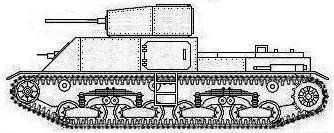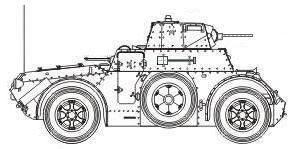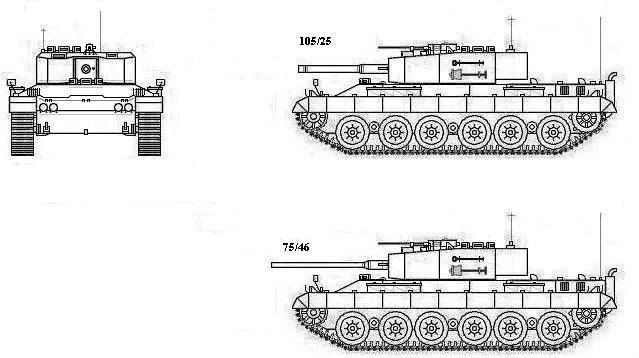You are not logged in.
Dear visitor, welcome to WesWorld. If this is your first visit here, please read the Help. It explains in detail how this page works. To use all features of this page, you should consider registering. Please use the registration form, to register here or read more information about the registration process. If you are already registered, please login here.




This post has been edited 1 times, last edit by "Red Admiral" (Jul 15th 2007, 1:06pm)


Quoted
Originally posted by Red Admiral
Length: 6.48m Width: 3.16m Height: 2.26m
Weight: 27,000kg
Crew: 4 (Driver, Gunner, Loader, Commander)
Engine: 350hp Isotta-Fraschini Asso 300 Petrol
Speed: 38km/h Range: 200km
Power/Weight: 13hp/ton Ground Pressure: 0.75kg/cm2
Armament: 1 x 105/25 with 70 rounds, 1 x 13.2mm Scotti with 1000 rounds, 1 x 8mm Breda with 3000 rounds
Armour: 70mm - 10mm
Given the current interest in tanks I thought this might be the time to post Italy's newest tank design. Throughout the 1930s so far there haven't been any really successful Italian tanks (only really the earlier Fiat 3000), mostly due to reliability problems. The M34 tanks saw service in Argentina and gave reasonable results despite reliability problems. As a result, Italy hasn't properly adopted a tank since the small scale issuing of the M30. Instead a relatively successful Semovente chassis has been built. The performance isn't outstanding but it is reliable and has lead to large numbers being built, especially for foreign countries. It also lead to a turreted version mounting a 47mm gun. Throughout the 1930s a number of prototype vehicles have been built, testing various new ideas, but the Esercito never put any of them into production, preferring to wait until there was a greater need. The rapid arming of countries in Balkans, coupled with rearmament in other European countries, lead matters to a head and resulted in a proper tank design being comissioned for introduction in the late 1930s.
The tank was built around the existing engine and transmission, with slight improvements increasing output by 50hp. The final drive was also reinforced to cope with the extra vehicle weight. For protection, the designers followed the trend of sloped armour plates apart from the turret which gave too many manufacturing problems. A cast turret was considered, but there was insufficient manufacturing experience available. Protection was focused on the frontal arcs, with armour grade steel being laid over a mild steel body to try and eliminate welding problems. The armament was to consist of the 105/25 howitzer, similar to that used in artillery regiments. Earlier designs had used the 75/18 howitzer but this was thought to have insufficient armour penetration against newer designs. The 105/25 gave good performance in the support role and was good enough for most armoured threats at the time. A number of examples were also trialled with the 75/46 gun, derived from the anti-aircraft weapon, which promised greater performance against tanks. The resulting vehicle was reliable in service and compared well with it's contemporaries. A redesign in the early 1940s with increased armour and a new engine gave a new lease of life.
Quoted
First, what year it will enter service? Second, IMO a little too light, but not by much. Maybe three to four tons more.
Quoted
Originally posted by Red Admiral
Quoted
First, what year it will enter service? Second, IMO a little too light, but not by much. Maybe three to four tons more.
Probably a few examples in 1938.
The closest historical vehicles are the T20/T23 series and the T-44. This has less armour and engine with consequent reduction in weight. 27-28tons seems reasonable.
Quoted
1938 is more than five years if we go with the T-44. IMO should be only prototypes with production in 1939 at the earliest?
Quoted
Originally posted by Red Admiral
Quoted
1938 is more than five years if we go with the T-44. IMO should be only prototypes with production in 1939 at the earliest?
But it _isn't_ the T-44. That just provides a benchmark for something a similar size and shape. If it had a bigger engine, a high velocity large calibre gun and a lot more armour you've have more of a point. It's pretty similar to the AT-36 and the Panzer IV with the 75/48 when it appears...
Forum Software: Burning Board® Lite 2.1.2 pl 1, developed by WoltLab® GmbH
